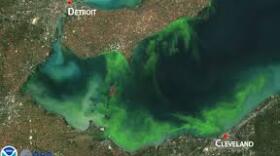The Ohio House and Senate have approved a measure aimed at reducing toxic algae blooms in Lake Erie and other waterways. The bill prohibits farmers from spreading manure on frozen and rain-soaked fields. It ends the dumping of dredged sediment in the lake within five years. Ohio Public Radio's Andy Chow reports.
Last summer, potentially dangerous toxins turned part of Lake Erie green and left nearly half a million people in Toledo unable to use the water. By that point the Ohio General Assembly had already been working on ways to reduce the growth of harmful algal blooms but the crisis in Toledo ramped up those efforts.
This year that came in the form of Senate Bill 1, which bans the application of manure on frozen, snow-covered or rain-saturated farmland.
Republican Senate President Keith Faber of Celina represents eastern Ohio and what he calls the largest agricultural district in the state. He said lawmakers wanted to make sure farming was still viable.
“But viability should not be confused with a lack of environmental stewardship and excessive use of chemical fertilizer or organic fertilizers is unacceptable and this bill will make meaningful changes into that process,” said Faber.
This is just the latest piece of legislation that works towards regulating nutrient runoff. Statehouse leaders have already passed measures to require nutrient management plans and better fertilizer application practices.
But as Republican Senator Bob Peterson of Sabina explains—more work went into this bill than the previous ones.
“This will be the toughest bill. It’s the most comprehensive and it’s the best because we had input from the agriculture community—a variety of different resources that we’ve talked about this is the right balance that we need to hit,” said Peterson.
Part of the complexities of the bill came in the form of exemptions. This includes a grace period—giving farmers time to adjust to the new standards. Lawmakers such as House Agriculture Committee Chairman Brian Hill—a Republican from Zanesville—said they wanted to make sure the law wasn’t overly burdensome to farmers.
“This is a big change and we’ve got to understand that these guys are going to need maybe a little bit of help—maybe a lot of help and a little bit of time to comply and if they’re trying we cannot slam them every time there’s a little hiccup,” Hill said.
And in the end farmers associations are happy with the final product. That includes the Ohio Farm Bureau Federation and Ohio Farmers Union.
Ron Sylvester is spokesperson for the Farmers Union. He says the agriculture industry is ready to do its part to improve water quality—however—he says there are still other factors to consider such as waste water treatment plants and septic tank use.
“These are public works projects that the general public—whether it’s local or statewide need to get their arms around so that everyone is doing their part and farmers aren’t the only ones paying this bill,” Sylvester said.
Environmental advocates are also supporting the bill, including Adam Rissien with the Ohio Environmental Council. He echoes Sylvester’s call to improve other contributors to algae growth but adds that more regulation is still needed to cut down on agriculture runoff.
“Until farmers and agricultural producers stop overapplying nutrients in other words only apply nutrients in the amount that plants really need to grow we’re going to see excess nutrients on the ground and eventually they make their way into the water,” said Rissien.
There are other bills up for the General Assembly’s consideration, including one that would address concerns with the standards for waste water treatment plants and public water systems.
This latest provision will now go to the governor’s desk for his signature.













